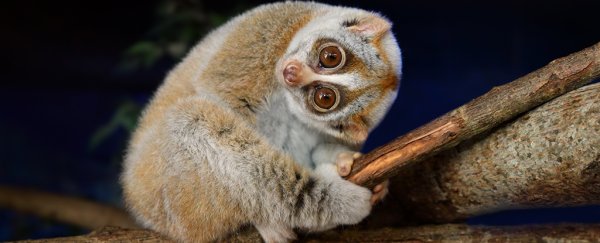For those with a severe cat allergy, any location that harbours a pet feline can become a toxic no-go zone. Research on another tragically cute mammal now suggests this might be no accident of nature – cats really are trying to keep us away.
A study on the world's only known example of a venomous primate has found a surprising similarity between a key protein in its armpit glands and the allergen found in cats, raising the suggestion that if one evolved as a defensive weapon, so might the other.
It's a finding that not only puts cat allergies into a new context, but could lead to treatments for those suffering the effects of an unpleasant encounter with either animal.
Slow lorises (Nycticebus sp.) are several species of primate commonly found in the wilds of South and Southeast Asia. Looking at one, you'd swear it was dreamed up in a Hasbro toy workshop for toddlers.
But don't let the looks fool you. Inside the loris's mouth are rows of tiny, razor-sharp teeth used to both tear into small prey and keep predators and competitors at bay.
As if a bite isn't enough, when threatened, the fluff monsters put their hands up and lick the glands tucked away in their armpits, dosing their spit with a rich array of compounds fine-tuned to help transform a tiny cut into a festering hole of dead flesh.
"Generally slow lorises use their venom to fight with other slow lorises, causing very slow-to-heal wounds," says biologist Bryan Fry from the University of Queensland in Australia.
"But, when humans are bitten, the victim will display symptoms as if they're going into allergic shock."
Those symptoms can include difficulty breathing, blood in the urine, extreme pain, and - in the worst cases - anaphylactic shock.
The secretions responsible for the toxic effects of the animal's bite are known to include more than two hundred aromatic compounds, many of which have already been characterised.
But among them are a bunch of proteins which still pose some mystery, and it's these chemicals that Fry and his team sequenced to learn more about their origins and toxicity.
Surprisingly, the proteins weren't entirely new to science. In fact, many of us are painfully familiar with them already.
"We analysed the DNA sequence of the protein in slow loris venom, discovering that it's virtually identical to the allergenic protein on cats," says Fry.
"Cats secrete and coat themselves with this protein, and that's what you react to if you're allergic to them."
Depending on where you live in the world, anywhere from one in ten to one in four people have to deal with the sniffles, itchy eyes, or potentially life-threatening swelling of the airways that comes with breathing in the allergenic proteins in cat saliva.
Those statistics aren't exactly trivial, suggesting there might be something less than random about the way these proteins evolved in cats and slow lorises to repel potential threats.
"The human allergy to cats is so prevalent that it would be a remarkable coincidence if this wasn't an evolved defensive weapon, like the same protein used by slow lorises," says Fry.
"Your pet cat wouldn't know it, but it may have evolved a toxic defence to keep predators as far away from it as possible."
The link is fairly speculative and demands further study. In any case, the discovery has important implications for mapping the immunological processes that prevent slow loris bites from healing, potentially leading to better allergy treatments or even novel medications.
Sadly, the primate's adorable little Ewok faces have made them irresistible commodities for Asian pet markets, where their obnoxious bite is dealt with by having the teeth unceremoniously ripped out.
As tragically popular as they've been in the exotic animal trade, researchers haven't been so quick to study the animals' unique abilities, which makes these latest results all the more fascinating.
"Slow lorises are the only known primates with venom and they've been virtually unstudied," says Fry. The animals the team studied had been brought into Indonesia's Cikananga Wildlife Rescue Centre, thus making the most of a sad situation.
This research was published in Toxins.
